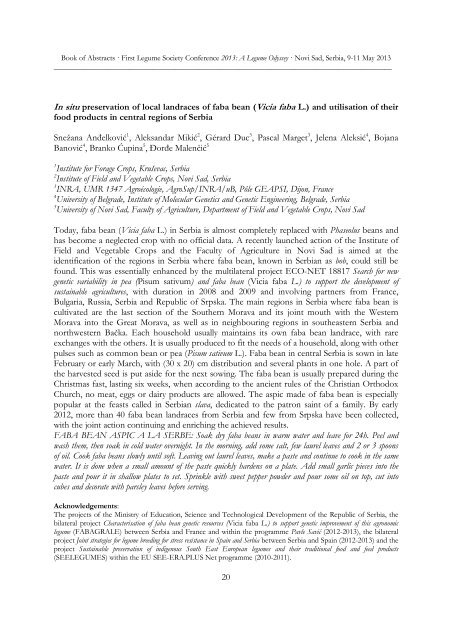Create successful ePaper yourself
Turn your PDF publications into a flip-book with our unique Google optimized e-Paper software.
Book of Abstracts <strong>First</strong> <strong>Legume</strong> <strong>Society</strong> <strong>Conference</strong> 2013: A <strong>Legume</strong> Odyssey Novi Sad, Serbia, 9-11 May 2013<br />
_________________________________________________________________________________________<br />
In situ preservation of local landraces of faba bean (Vicia faba L.) and utilisation of their<br />
food products in central regions of Serbia<br />
Snežana Anñelković 1 , Aleksandar Mikić 2 , Gérard Duc 3 , Pascal Marget 3 , Jelena Aleksić 4 , Bojana<br />
Banović 4 , Branko Ćupina 5 , ðorñe Malenčić 5<br />
1 Institute for Forage Crops, Kruševac, Serbia<br />
2 Institute of Field and Vegetable Crops, Novi Sad, Serbia<br />
3 INRA, UMR 1347 Agroécologie, AgroSup/INRA/uB, Pôle GEAPSI, Dijon, France<br />
4 University of Belgrade, Institute of Molecular Genetics and Genetic Engineering, Belgrade, Serbia<br />
5 University of Novi Sad, Faculty of Agriculture, Department of Field and Vegetable Crops, Novi Sad<br />
Today, faba bean (Vicia faba L.) in Serbia is almost completely replaced with Phaseolus beans and<br />
has become a neglected crop with no official data. A recently launched action of the Institute of<br />
Field and Vegetable Crops and the Faculty of Agriculture in Novi Sad is aimed at the<br />
identification of the regions in Serbia w<strong>here</strong> faba bean, known in Serbian as bob, could still be<br />
found. This was essentially enhanced by the multilateral project ECO-NET 18817 Search for new<br />
genetic variability in pea (Pisum sativum) and faba bean (Vicia faba L.) to support the development of<br />
sustainable agricultures, with duration in 2008 and 2009 and involving partners from France,<br />
Bulgaria, Russia, Serbia and Republic of Srpska. The main regions in Serbia w<strong>here</strong> faba bean is<br />
cultivated are the last section of the Southern Morava and its joint mouth with the Western<br />
Morava into the Great Morava, as well as in neighbouring regions in southeastern Serbia and<br />
northwestern Bačka. Each household usually maintains its own faba bean landrace, with rare<br />
exchanges with the others. It is usually produced to fit the needs of a household, along with other<br />
pulses such as common bean or pea (Pisum sativum L.). Faba bean in central Serbia is sown in late<br />
February or early March, with (30 x 20) cm distribution and several plants in one hole. A part of<br />
the harvested seed is put aside for the next sowing. The faba bean is usually prepared during the<br />
Christmas fast, lasting six weeks, when according to the ancient rules of the Christian Orthodox<br />
Church, no meat, eggs or dairy products are allowed. The aspic made of faba bean is especially<br />
popular at the feasts called in Serbian slava, dedicated to the patron saint of a family. By early<br />
2012, more than 40 faba bean landraces from Serbia and few from Srpska have been collected,<br />
with the joint action continuing and enriching the achieved results.<br />
FABA BEAN ASPIC A LA SERBE: Soak dry faba beans in warm water and leave for 24h. Peel and<br />
wash them, then soak in cold water overnight. In the morning, add some salt, few laurel leaves and 2 or 3 spoons<br />
of oil. Cook faba beans slowly until soft. Leaving out laurel leaves, make a paste and continue to cook in the same<br />
water. It is done when a small amount of the paste quickly hardens on a plate. Add small garlic pieces into the<br />
paste and pour it in shallow plates to set. Sprinkle with sweet pepper powder and pour some oil on top, cut into<br />
cubes and decorate with parsley leaves before serving.<br />
Acknowledgements:<br />
The projects of the Ministry of Education, Science and Technological Development of the Republic of Serbia, the<br />
bilateral project Characterisation of faba bean genetic resources (Vicia faba L.) to support genetic improvement of this agronomic<br />
legume (FABAGRALE) between Serbia and France and within the programme Pavle Savić (2012-2013), the bilateral<br />
project Joint strategies for legume breeding for stress resistance in Spain and Serbia between Serbia and Spain (2012-2013) and the<br />
project Sustainable preservation of indigenous South East European legumes and their traditional food and feed products<br />
(SEELEGUMES) within the EU SEE-ERA.PLUS Net programme (2010-2011).<br />
20


